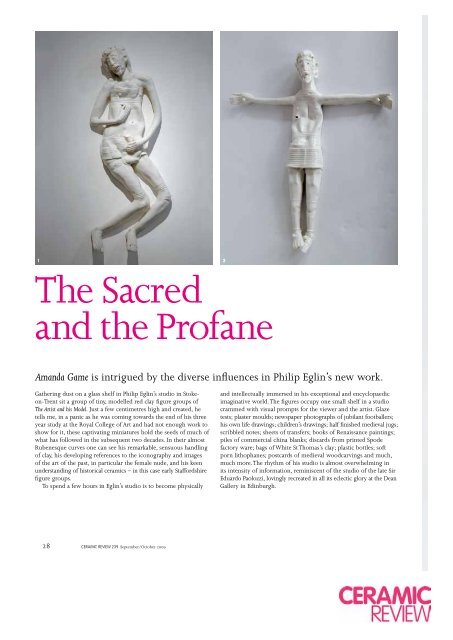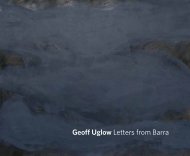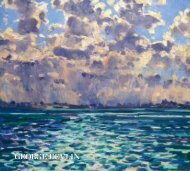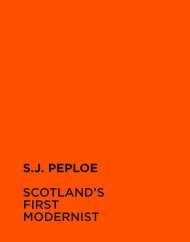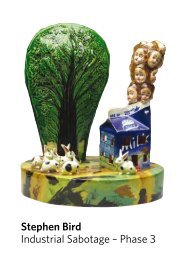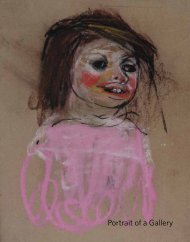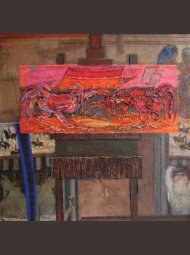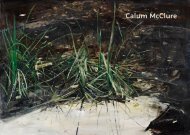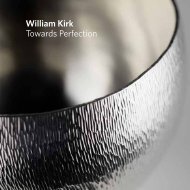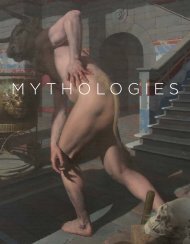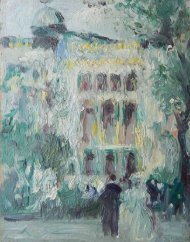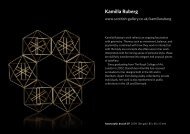Download PDF: Philip Eglin Ceramic Review Issue 239
Download PDF: Philip Eglin Ceramic Review Issue 239
Download PDF: Philip Eglin Ceramic Review Issue 239
You also want an ePaper? Increase the reach of your titles
YUMPU automatically turns print PDFs into web optimized ePapers that Google loves.
1 2<br />
The Sacred<br />
and the Profane<br />
Amanda Game is intrigued by the diverse influences in <strong>Philip</strong> <strong>Eglin</strong>’s new work.<br />
Gathering dust on a glass shelf in <strong>Philip</strong> <strong>Eglin</strong>’s studio in Stokeon-Trent<br />
sit a group of tiny, modelled red clay figure groups of<br />
The Artist and his Model. Just a few centimetres high and created, he<br />
tells me, in a panic as he was coming towards the end of his three<br />
year study at the Royal College of Art and had not enough work to<br />
show for it, these captivating miniatures hold the seeds of much of<br />
what has followed in the subsequent two decades. In their almost<br />
Rubenesque curves one can see his remarkable, sensuous handling<br />
of clay, his developing references to the iconography and images<br />
of the art of the past, in particular the female nude, and his keen<br />
understanding of historical ceramics – in this case early Staffordshire<br />
figure groups.<br />
To spend a few hours in <strong>Eglin</strong>’s studio is to become physically<br />
28<br />
CERAMIC REVIEW <strong>239</strong> September/October 2009<br />
and intellectually immersed in his exceptional and encyclopaedic<br />
imaginative world. The figures occupy one small shelf in a studio<br />
crammed with visual prompts for the viewer and the artist. Glaze<br />
tests; plaster moulds; newspaper photographs of jubilant footballers;<br />
his own life drawings; children’s drawings; half finished medieval jugs;<br />
scribbled notes; sheets of transfers; books of Renaissance paintings;<br />
piles of commercial china blanks; discards from printed Spode<br />
factory ware; bags of White St Thomas’s clay; plastic bottles; soft<br />
porn lithophanes; postcards of medieval woodcarvings and much,<br />
much more. The rhythm of his studio is almost overwhelming in<br />
its intensity of information, reminiscent of the studio of the late Sir<br />
Eduardo Paolozzi, lovingly recreated in all its eclectic glory at the Dean<br />
Gallery in Edinburgh.
1 Christ after Hugo van der Goes, porcelain,<br />
2008, H63cm 2 Crucifixion, porcelain,<br />
2008, H53cm 3 Pieta, raku, 2009, H43cm<br />
3
4<br />
RCA AND AFTER Paolozzi was one of <strong>Eglin</strong>’s tutors at the RCA and<br />
the young potter was pressed into service in the sculptor’s studio,<br />
modelling and making moulds – a practical training of some use to<br />
an emerging maker. Yet there is little stylistic trace of the mechanistic,<br />
robotic figure forms which are typical of the work of the Scottish<br />
artist. From the moment of graduation from the RCA in 1986 <strong>Eglin</strong>’s<br />
gaze has rested almost exclusively on the female form. The high<br />
bosomed, loosely modelled earthenware nudes inspired by the<br />
sinuous knowingness of Lucas Cranach’s paintings gave way to<br />
the blunt polychrome Madonna and Child figures that echo the physical<br />
qualities of the medieval religious woodcarvings, which are their<br />
visual inspiration. As <strong>Eglin</strong> says, clay has the potential ‘to mimic the<br />
essence of other materials’, something which clearly fascinates him<br />
in the same way that an artist like Gerhard Richter is fascinated by<br />
the potential of the painted surface; both to be and to represent<br />
many things.<br />
As we walk into the studio <strong>Eglin</strong> remarks that his forthcoming<br />
show at the Scottish Gallery is ‘all about religion’. A sheet of oxide<br />
transfers juxtaposing popes and prostitutes – mostly transfers derived<br />
from his own drawings as well as those made by his two sons Oliver<br />
and Morgan – highlights the ambiguity contained within these<br />
throwaway words. As John Christian observed, <strong>Eglin</strong> has an ‘eagerness<br />
to associate opposites: the ancient and the modern; the universal<br />
and the private; the sacred and the profane’. In the new work being<br />
moulded, modelled and considered in the studio, this duality is<br />
clearly apparent. Plastic juice bottles, littering the streets around<br />
his workshop, are seen as possible moulds for the bodies of his<br />
Christ figures in a new series of stoneware Crucifixions.<br />
To see at close quarters the compelling transformation of ribbed<br />
plastic waste into the stretched ribs of Christ in agony – as represented<br />
by thousands of carvers and painters throughout medieval Europe – is<br />
to understand the particular brilliance of <strong>Eglin</strong>’s visual alertness and<br />
his fascination with the transfer of language. A new group of seated<br />
Madonnas, assembled likewise from moulds of household waste, are<br />
30<br />
CERAMIC REVIEW <strong>239</strong> September/October 2009<br />
5
4 Three Dog dishes, raku, 2009,<br />
Ø12cm each 5 Pieta, earthenware, 1999,<br />
H90cm 6 Christ as the Man of Sorrows,<br />
earthenware, 2008, Ø18cm 7 Pope and<br />
Prostitute, raku, 2009, W21cm<br />
6<br />
7<br />
being subjected to raku firings, which creates a softer quality of<br />
surface texture – with glimmerings of lustre – echoing the bleached,<br />
weathered quality of lime-wood medieval carvings. <strong>Eglin</strong> improvises<br />
within the language of clay to find visual equivalents for his fascination<br />
with different forms of language – both visual and verbal.<br />
RAKU <strong>Eglin</strong> describes his excitement with the immediacy of the<br />
raku firing process – an excitement reanimated by a recent workshop<br />
with first year students at Stoke University where he teaches. The<br />
workbench on which the nascent Madonnas sit is covered with test<br />
pieces where he is trying to ensure that the definition of the transfer<br />
drawings is retained within the softness of the raku glazes, a process<br />
CERAMIC REVIEW <strong>239</strong> September/October 2009 31
8<br />
that involves fixing the transfers to the raw unglazed surface with<br />
latex. Although these laboratory test pieces suggest an artist with a<br />
scientific rigour of approach, <strong>Eglin</strong> is quick to dismiss any image of<br />
himself as the careful technologist. It is, he stresses, ‘at the point of<br />
unknowing that the magic happens’, and all the testing can be seen<br />
as the artist’s way of relaxing into a rhythm of thinking, like musical<br />
improvisation, to reach the right note.<br />
A recent exhibition at the Nieuwe Kerk in Amsterdam (a secular<br />
exhibition space in a fifteenth century church) drew together works<br />
with religious iconography from the collections of the Stedelijk<br />
Museum and reunited <strong>Eglin</strong>’s earlier porcelain Madonnas with their<br />
spiritual home. The preciousness and vulnerability of the small-scale,<br />
white, gilt-edged figures, was enhanced through display in carefully<br />
lit, well-positioned glass cases in the historic church spaces – much<br />
like tiny altar pieces, their contemporary nature complemented by<br />
juxtaposition with paintings by Julian Schnabel and the photographic<br />
collages of Gilbert and George. <strong>Eglin</strong> was delighted by a display that<br />
emphasised his enquiry into contemporary image-making whilst<br />
respecting his fascination for objects of the past.<br />
32<br />
CERAMIC REVIEW <strong>239</strong> September/October 2009<br />
9<br />
10
8 Tomorrow's Assassin, earthenware,<br />
2008, H52cm 9 La Nuova Religione,<br />
earthenware, 2008, H55cm 10 Poppadum<br />
Madonna, bone china, 2006, H43cm<br />
11 Plaster moulds 12 Workshop wall<br />
11<br />
12<br />
Technical Information See page 68<br />
Photography Oliver <strong>Eglin</strong><br />
Exhibition Popes, Pin-ups and Pooches,<br />
The Scottish Gallery, Edinburgh, until<br />
5 September 2009<br />
Web www.scottish-gallery.co.uk<br />
<strong>Philip</strong> <strong>Eglin</strong><br />
Email phileglin@ntlworld.com<br />
Amanda Game<br />
Email amanda.game@yahoo.co.uk<br />
The new group of Madonnas, transfer printed plates and Crucifixions,<br />
on show in Edinburgh this summer, reveal an artist reaching a<br />
new confidence and maturity with his language. The duality, the<br />
playfulness and the ambiguity of <strong>Eglin</strong>’s new work draws the viewer<br />
into a fascinating conversation with the nature of objects and their<br />
role in allowing us to consider both ourselves, and the world<br />
around us, in different ways. It is an exciting moment to be part<br />
of <strong>Eglin</strong>’s journey.<br />
CERAMIC REVIEW <strong>239</strong> September/October 2009 33


